An almost ideal VCO for small, portable module systems: The A-111-3 measures just 4 TE! At its core, it is the same VCO as the A-111-2 High End VCO II, which, however, is much more luxuriously equipped. So, again, we’re dealing with a highly tuning stable oscillator that offers pretty perfect tracking of 1V/octave over 10 octaves. Of course, the question immediately arises: what was saved on? After all, the A-111-3 costs about 100 euros less than its “big brother”.
The most obvious limitation for me: The octave selector switch is missing. The preselection option over 6 octaves with the A-111-2 or even 8 octaves with the old A-111-1 is quite suitable for a VCO that offers clean tracking over approx. 10 octaves. The “closely related” VCOs A-111-4, A-111-5 and A-111-6 (as well as the very differently constructed A-110-2) have at least a simple three-way switch for +1/0/- 1 octave. Logically, with the A-111-3, an A-185-2 Precision Adder will be used to set additional octave positions. With more than one VCO in monophonic sounds, the A-185-2 (or something similar) should be used as a buffered multiple anyway. Otherwise there is only a single “Tune” control – the A-111-2 also has a “Fine” control for fine tuning, as well as an “LF” control with which you can “screw down” to almost zero Hz . However, the “XM” controller on the A-111-3 can be used for fine-tuning as long as there is no control voltage at the “XM” input, very practical! The two inputs for linear frequency modulation “LM” and pulse width modulation “PM” do not have an attenuator. If required, you can use an A-183-1 Dual Attenuator or the new A-183-5 Quad Attenuator, for example.
And otherwise? There is only one single sync input (two different ones on the A-111-2), but it can be switched between the Curtis-typical “Hard Sync” and “Soft Sync” with a jumper, which is not a problem in practice. And the sine output is missing, fans of the classic FM (frequency modulation) will miss it or get the A-184-2 Sine Converter, which has the same precise sine circuit as the A-111-2.
But with all of these “compensating” additional modules, you’re placed much wider in the rack and more expensive than with a single A-111-2. The A-111-3 is “worthwhile” if you can actually largely do without the saved features or only specifically need them for individual A-111-3 VCOs. But then you have a very high-quality and space-saving VCO.
User interface
Inputs:
System bus: As with the A-110-1 or A-111-1, the pitch of the A-111-3 can be controlled via a voltage applied to the system bus. The system bus can be addressed with an A-185-1 or A-185-2 or, if necessary, deactivated with a jumper on the circuit board.
As with all VCOs with CV control via the bus, you should deactivate this option if you are not using it: Otherwise, the open lines could work as “antennas” and pick up interference signals.

- XM: The XM input is an exponential input for pitch modulation, it has an “XM” attenuator. Input and attenuator correspond to the “XFM” on the A-111-2.
- LM: Control voltage input for linear frequency modulation. This input has no attenuator.
- 1V: Control voltage input with exponential characteristics (1 volt per octave) for controlling the pitch of the VCO, e.g. with a CV keyboard or a sequencer. The input has no attenuator.
- PM: Control voltage input for modulating the pulse width of the square waveform (affects its output only). Corresponds to the “PWM” input on the A-111-2, but has no attenuator here.
- SY: Input for soft or hard sync (depending on the jumper position on the board). The input reacts to a steep rising edge, i.e. a square-wave signal from another VCO is usually applied here.
Outputs:
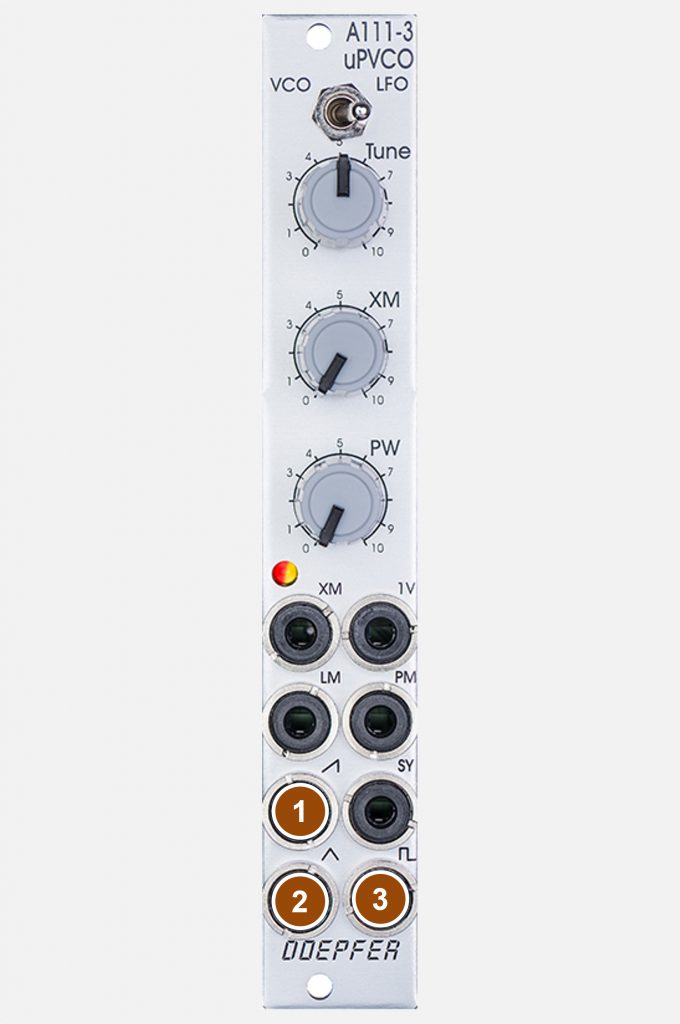
- Sawtooth: Audio output for the VCO’s sawtooth signal.
- Triangle: Audio output for the VCO’s triangle signal.
- Square: Audio output for the square or pulse signal of the VCO.
Controls:
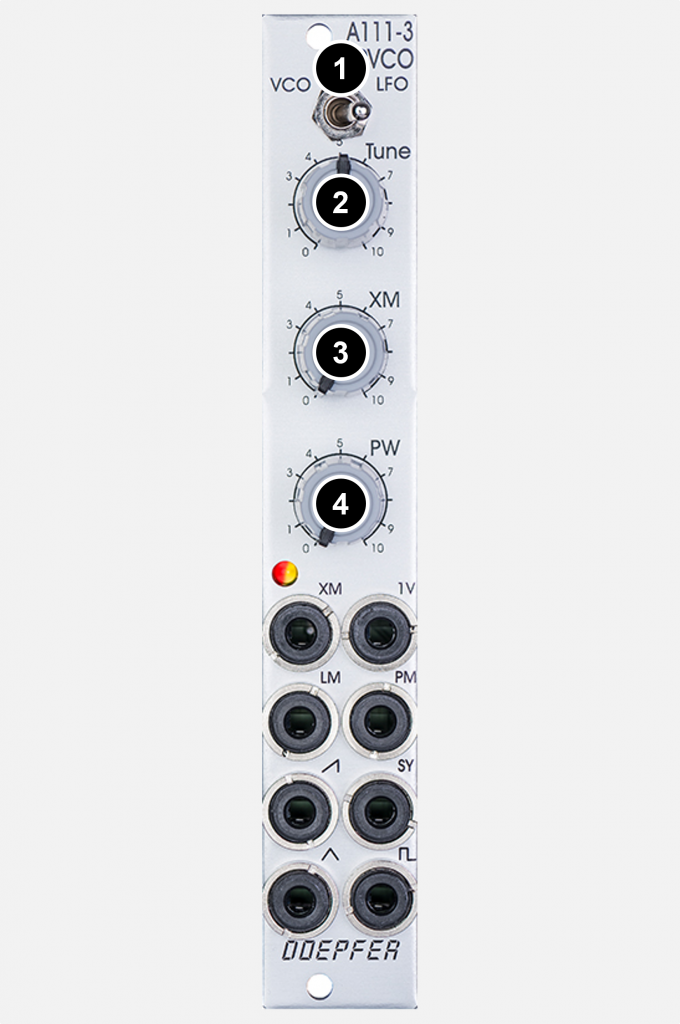
- “VCO” – “LFO” switch: Here you can switch between conventional audio operation (“VCO”) and “LFO” operation, which is slower by a factor of 1:500. This gives us an extremely luxurious LFO with frequency modulation, pulse width modulation and sync (or reset) options.
- Tune: Control for tuning the oscillator. A control range of about 0.5 octaves, 2 octaves or 10 octaves can be selected with a jumper on the circuit board.
- XM: Attenuator for the exponential control voltage input “XM”. Without an input signal, there is a slight voltage here, with the help of which the controller can then also be used as a fine-tuning controller.
- PW: Controller for the pulse width of the square/pulse signal. The middle position corresponds to the symmetrical square-wave signal, to the left and right, the pulse wave increasingly narrows or broadens. As is usual with Doepfer VCOs, with the A-111-3 we also achieve the full 0% and 100% pulse width with the control fully left or right, at which point the sound then breaks off.
Waveforms
As expected, the waveforms are extremely clean, with a triangle core VCO of course the triangle is particularly important. With sawtooth and square/pulse there are small additional oscillations at the reversal points, but the “crossbar” with the square is remarkably stable.
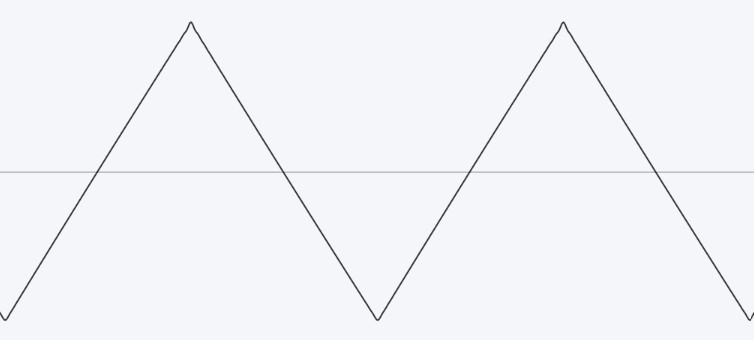


Compared to the A-111-1, the rectangle of the A-111-3 is much more “square” overall (i.e. the tension is better maintained in the “crossbars”), albeit with slight overshoots, which the A-111-1 avoids. The sawtooth is similarly correct, but also has slightly more “dirt” at the reversal points:



Possible uses
Just another VCO
As banal as it sounds: Sometimes you need several VCOs for a sound, but not all of them have to offer the full range of possibilities that a (significantly more expensive and larger) A-111-1 or A-111-2 has on board, for example . The A-111-3 is therefore an ideal companion for a complex high-end VCO and does the “bread and butter” work. A buffered multiple like the A-180-3 or an A-185-2 Precision Adder then ideally controls both (or three or more…) VCOs via the A-100 bus.
The A-111-3 is also a nice addition to the A-111-6 miniature synthesizer if it is fed into the sound processing via its “Ext. In” input.
Polyphony
Yes, of course, we have the A-111-4 Quad / Polyphonic VCO, which is predestined for polyphony, not least because of its pre-wiring via the CV pins on the circuit board and a common control section. Nevertheless, the A-111-3 is an interesting addition or even an alternative to the A-111-4:
- More control options without having to unscrew the module from the rack and reconfigure it via jumpers (exponential and linear FM are always available as separate input sockets, as is PWM).
- Manual adjustment of the pulse width!
- With 10 Vpp (0V … +10V or -5V … +5V for triangle) the audio outputs are designed a little “hotter” than the 5 Vpp outputs (-2.5V … +2 .5V) on the A-111-4. Filter overdrive is slightly easier and more intense to achieve with the higher levels of the A-111-3.
However, 4 pieces of the A-111-3 are also significantly more expensive than a single A-111-4. So you will have to weigh the benefits against the costs. In addition, an additional A-185-2 Precision Adder makes sense if you need to control several VCOs together: You get separate +/-1 octave switches, common exponential modulation – e.g. for vibrato, and a common 1V/octave input for transposition, analogous to the “master section” on the A-111-4.
LFO resp. VCLFO
Well, Doepfer is certainly not lacking in offers for LFOs with very different application profiles. Nevertheless, switching to LFO mode on the A-111-3 is pretty exciting: All options such as PW and PWM, sync (or LFO reset), linear and exponential FM are of course retained in LFO mode. Few LFOs offer that.
If you need even more possibilities with an LFO, you might like to use the new A-147-4 Dual VCLFO (which still has a sine wave and a falling sawtooth). or to the A-147-2, which also has a built-in VCA/polarizer with attack generator. And if you need a continuous transition between triangle and rising/falling sawtooth, then you can’t get around the A-146. Of course, the (significantly more expensive) A-111-2 also offers a comparable switchover to LFO mode. That’s a maximum of luxurious “LFO”.
Configuration via the board
The A-111-3 also has a number of configuration options, which can be done very easily using jumpers (plug-in bridges) on the circuit boards.
Bus access and sync
Jumper JP2 can be used to determine whether the VCO should be controlled via a control voltage on the A-100 bus. Midi interfaces usually use the bus for their control voltage, but also e.g. the A-185-2 Precision Adder / Bus Access, which is highly recommended when using several VCOs anyway.
| JP2 set | The VCO is controlled by the bus CV. Voltages from the bus are added to control voltages at the input “1 V” (or “LM” and “XM”). |
| JP2 not set | The VCO works independently from the bus CV. |
Jumper JP3 can be used to determine whether the synchronization of the VCO (input socket “SY”) is soft or hard sync. The two versions differ significantly in terms of sound.
| JP3 position above* | Hardsync |
| JP3 position below* | Softsync |
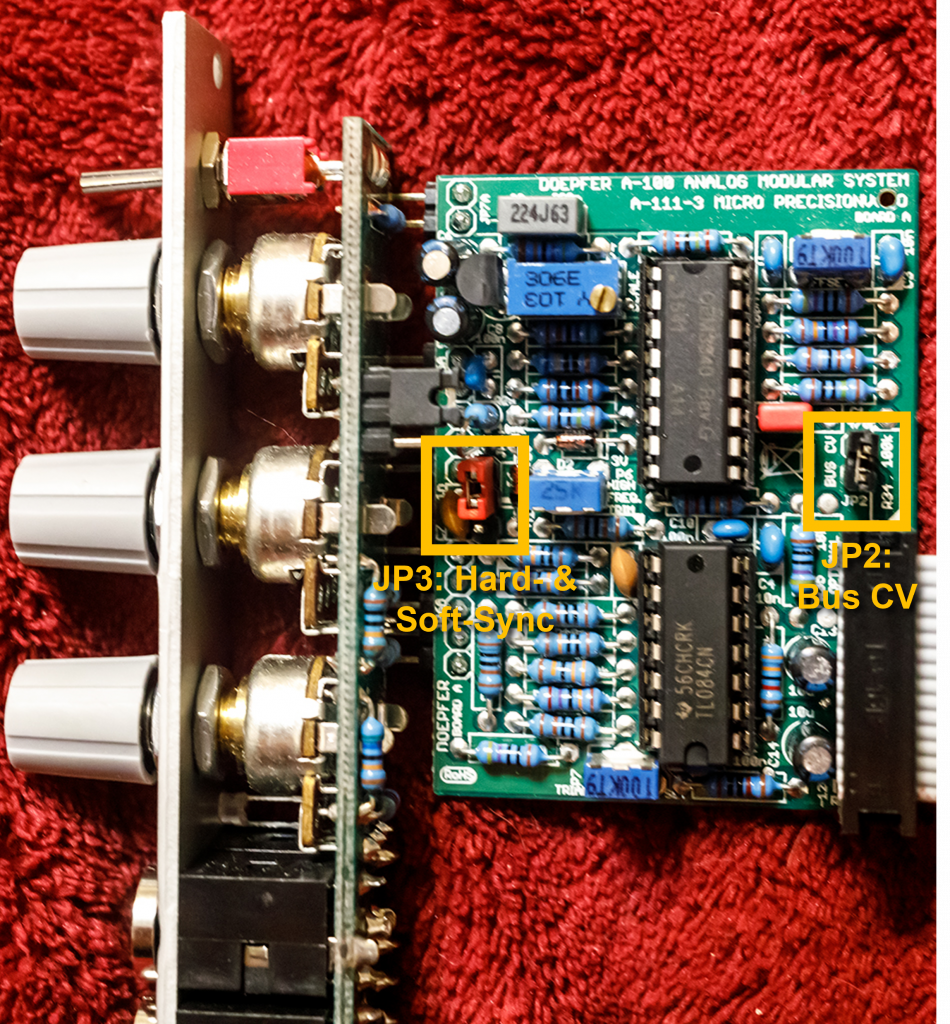
Polyphonic prewiring
With its space-saving dimensions and the significantly more flexible modulation options compared to the A-111-4 (at least without having to unscrew the module from the rack), the A-111-3 is an interesting candidate for polyphonic systems. However, it has the shortcoming of missing pre-wiring to control the pitch with the A-190-5 without having to use extra patch cables.
As a makeshift, you can use the jumper JP2 mentioned above on the circuit board of the A-111-3 for something other than its intended purpose: If you remove the jumper, the voltage from the bus is present at the lower pin (see illustration, label “Board A” on the top right of the board) and the upper pin is the input for the CV control of the VCO. You can then put a jumper cable (or “Arduino cable”) on this upper pin and connect it to one of the CV-Note outputs on the board of an A-190-5 midi interface.
However, this pre-cabling is permanent: A patch cable in the “1V” input does not interrupt the voltage from the pre-cabling – in contrast to the A-111-4 – the voltages are added instead. The pin on JP2 behaves exactly like the bus accesses of almost all other VCOs (with the exception of the A-110-1, which interrupts the bus access via a switching socket). In addition, you lose the ability to transpose multiple A-111-3 via an A-185-2 Precision Adder / Bus Access.
Tune range
The control range of the “Tune” control, which is responsible for the tuning of the VCO, can be set with jumper JP4.
| JP4 above* | About 2 octaves control range. A good compromise solution, in order to be able to carry out longer manual “journeys” through the VCO tuning, while an exact tuning with the “Tune” control is still possible with some degree of sensitivity. |
| JP4 below* | About 10 octaves control range. In this setting, you will hardly find an exact pitch with the “Tune” control (if necessary, use “XM” for fine tuning). In return, you have an enormous amount of leeway, for example for effect sounds, sync and frequency modulation, but also when using the module as an LFO. |
| JP4 removed | Approximately 1/2 octave control range. Very precise tuning of the VCO is possible directly with the “Tune” control, so the exponential modulation does not have to be used for fine tuning. Larger intervals (e.g. sevenths, etc.) must be set with a separate A-185-2 (via the A-100 bus). |
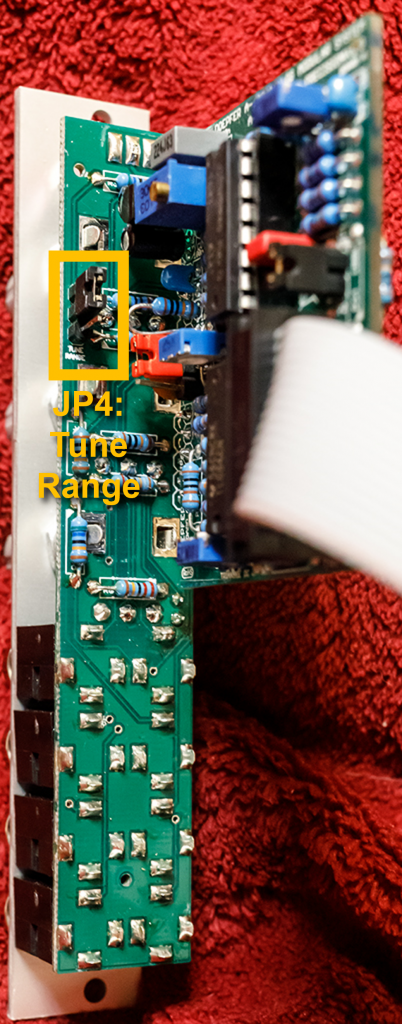
Alternatives
If the A-111-3 is attractive to you because of its small width of only 4 TE, then there really is no alternative within the Doepfer VCOs. Even the space-saving A-110-2 Basic VCO is twice as wide.
With a desire for polyphonic use, the advantage melts away a bit. With 18 TE, the A-111-4 Quad Precision VCO is only slightly wider than four A-111-3, but is significantly cheaper and already designed for the internal poly pre-wiring, which the A-111-3 only offers via the “trick” with jumper JP2.
The direct “competitors” are the other “high end” VCOs from Doepfer with a triangle core:
| Module | Width | Waveforms | Sync | FM | PW / PWM |
|---|---|---|---|---|---|
| A-111-1 | 14 HP | Pulse*, sawtooth, triangle, sine | Soft & hard (2 input jacks) | 2 x exponential, 1 x linear | PW manually, CV input for PWM with attenuator |
| A-111-2 | 14 HP | Pulse*, sawtooth, triangle, sine | Soft & hard (2 input jacks) | 2 x exponential, 1 x linear | PW manually, CV input for PWM with attenuator |
| A-111-3 | 4 HP | Pulse*, sawtooth, triangle | Soft or hard (jumper) | 2 x exponential, 1 x linear | PW manually, CV input for PWM without attenuator |
| A-111-4 (4 VCOs) | 18 HP | Square**, sawtooth, triangle | Soft or hard (jumper) | 1 x exponential, 1 x linear (or PWM, selectable via jumper) | no manual PW, CV input for PWM (alternative to Lin. FM) with attenuator |
** Square: Without PWM modulation voltage, only a square wave signal can be output.
If you can do without tracking over as large an area as possible and are only looking for an inexpensive VCO, then the A-110-2 is an alternative: It doesn’t offer a sine wave output either, the tracking isn’t quite as good as with the A-111 VCOs, but soft and hard sync are equipped with separate sockets and the price is significantly lower than that of the A-111-3.
Sound examples
-
A-111-3, A-111-6, A-149-4 / Random sequence
Four A-111-3 Micro Precision VCOs (sawtooth) are used as an additional sound source for four A-111-6 Miniature Synthesizers (VCO set to triangle, filter without resonance). The pitches are controlled by two A-149-4 Quad Random Sources.
The triggers for the random sources and the mini synthesizers come from an A-152 addressed T&H / switch, which is controlled with two square LFOs from an A-145-4 quad LFO (clock in and common T&H input).
I change the parameters at the two random sources (range and scales) as the process progresses. Since the cutoff-frequencies of the filters in the A-111-6 are normalized to the control voltages for the VCOs, the filter frequencies also change with higher pitches from the random generator. Some reverb and delay from the DAW.
Random sequence with four A-111-3 / A-111-6 and two A-149-4. -
A-111-3, A-111-6, A-149-4 / Random sequence with filter FM
Four A-111-3 Micro Precision VCOs (triangle) are used as modulation sources (inputs “FM1”) for the filters of four A-111-6 Miniature Synthesizers (VCO set to sawtooth). The pitches are controlled by two A-149-4 Quad Random Sources.
The triggers for the random sources and the mini synthesizers come from an A-152 addressed T&H / switch, which is controlled with two square LFOs from an A-145-4 quad LFO (clock in and common T&H input).
I start without filter FM and without resonance of the filters and change the parameters at the two random sources (range and scales) as well as (from about 1:50) the filter modulation depths, cutoff-frequencies and resonances of the filters. Since the cutoff-frequencies of the filters in the A-111-6 are normalized to the control voltages for the VCOs, the filter frequencies also change with higher pitches from the random generator. Some reverb and delay from the DAW.
Random sequence with four A-111-3 as modulation sources for the filter FM of four A-111-6 mini synthesizers. -
A-111-3, A-111-4, A-150-8 / Polyphonic VCO-Switching
In this patch I use four A-111-3 VCOs as an alternative to the four VCOs in an A-111-4 poly VCO. The audio signals (each sawtooth) are switched per voice between A-111-3 and A-111-4 by an A-150-8 octal VC switch and then filtered in an A-105-4 quad poly VCF.
The voices are played manually on a midi keyboard, which controls the VCOs via a polyphonic A-190-5 midi interface and triggers the two A-141-4 quad polyphonic ADSRs. Der erste Poly-ADSR steuert das A-105-4 Filter, der zweite einen A-132-8 Octal Polyphonic VCA.
The switching operations in the A-150-8 switch are controlled by the square-wave outputs of an A-143-4 Quad VCLFO/VCO, the LFO speeds are also controlled per voice from the “CV Note” outputs of the A-190-5 interface (roughly approx. 1V/octave). Each keystroke resets the corresponding LFO so that the switching processes start in sync with the notes.
Some reverb and delay from the DAW. Otherwise, I just doodle on the keyboard.
You can hear the volume differences between the A-111-4 (5 Vpp) and the A-111-3 VCOs (10 Vpp) very clearly, which also saturate the filters to different degrees.
Four A-111-3 VCOs are used alternately with the VCOs of an A-111-4, controlled by four LFOs. You could of course use four VCAs instead, which achieve a similar effect with different volumes, but it is something different when two different VCOs do the job, which (despite hopefully reasonably careful tuning) then have very small differences in pitch, but also in the sound spectrum.
-
A-111-3, A-111-4, A-149-5 / Polyphonic sequence with linear FM
Four A-111-3 VCOs (triangle outputs) are used as modulation sources for frequency modulation (linear) of the four VCOs in an A-111-4 (sawtooth outputs). All VCOs are controlled by an A-190-5 Poly Midi interface, so the modulators are (roughly) the same pitch as the modulated VCOs.
The sawtooth signals are filtered by an A-105-4 poly VCF and then amplified in an A-132-8 poly VCA. Filter and VCA are each controlled by an A-141-4 Poly ADSR. The A-111-3 VCOs cannot be heard directly and are only a modulation source.
The amount of frequency modulation is controlled using four channels in an A-130-8 via the velocities (also from the A-190-5). The little polyphonic sequence is from an Arturia KeyStep Pro.
In addition, one channel of an A-149-4 transposes the four A-111-4 VCOs simultaneously via the shared 1V input. The Random Generator is triggered by the first voice of the A-190-5. The A-111-3 VCOs are not transposed.
I start without random transposition, then increase the “Range” value in the A-149-4, first only with octaves, later also with fifths and chords, finally with the major scale and back again. At the very end the frequency modulation is withdrawn and the filter is slowly closed.
Linear FM with four A-111-3 and one A-111-4.
Technical specifications
| Width | 4 HP |
| Depth | 65 mm |
| Power requirements | 30 mA (+12V) / -20 mA (-12V) |
